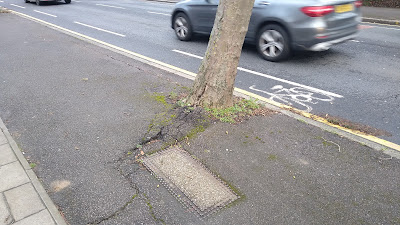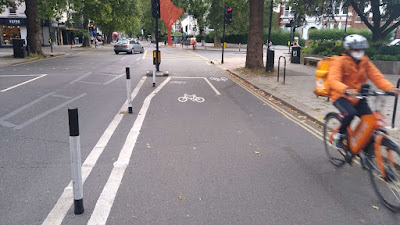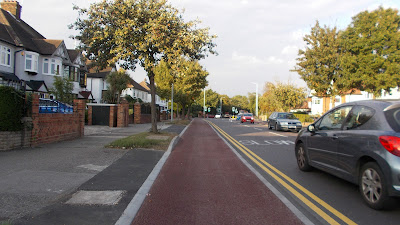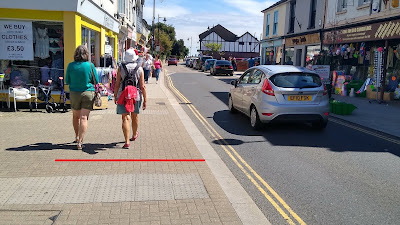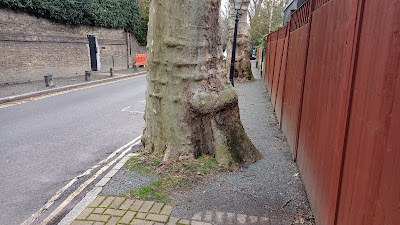With a day off work and sunny weather forecast, I availed myself of a train ticket and headed to the coast for a long overdue trip to the City of Brighton & Hove. Of course, I was a bit more interested in infrastructure than the beach!
Back in the summer of 2014, I visited the city with the Cycling Embassy of Great Britain (my posts here and here) and yet again, Mark Strong of Transport Initiatives gave up his time to show me around. It was doubly nice to see him in person after a couple of years of the Pandemic putting a bit of hold on such things. It also made a great change from reporting from London and so I'm looking forward to getting a bit further afield more often.
I had fancied trying the city's bike share, BTN Bikeshare, as well as looking at a couple of bits of cycling infrastructure and so after arriving at Brighton Station, I found myself a hire dock and set about retrieving a cycle, having pre-registered for the "Easy Rider" option with the system's app.
The Easy Rider option charges £1 to unlock a bike and then 3p per minute in use, so if you do two separate trips in a day, you'll be charged the £1 unlocking fee for each trip plus use. For regular users there's annual option which includes 30 minutes of riding per day and so even if you do a little more than that, it's still a competitive price.
There are two models of cycle in use. The newer version (above) is a bit of a tank, but living at the seaside means they have to be fairly robust and if I'm honest, they don't seem as well maintained as the London scheme that I am more used to. But with 8 gears, the ride was pretty good, although the front basket was a bit small and being handlebar-mounted, you'd have to watch the weight anyway, despite it being dampened.
There are a few ways to hire and unlock. For the first bike I used, I keyed in my account number and pin via the keypad (below) on the back of the bike and for the second, I used the app where you hire from the dock and you are allocated the bike number to unlock.
The technology used is a combination of an "active" bike with on-board GPS and keypad, and a "passive" dock which is essentially a row of big steel plates with a holes at the top. The bikes have their own U-locks which is a U-shaped bar which goes into two holes on the side of the bike and the hole on the plate on the dock (above). When hired, you pop the U-bar into the holder on the side (below).
There is a facility whereby you can lock the bike up using the U-bar on any cycle stand or post and keep the bike hired (although you do still pay per minute). This could be useful if you are running errands. When you have finished your ride, you stop at the dock and lock up the bike with the U-bar and the hire ends (I assume the docks are geofenced). You also have the option of parking up and ending the hire anywhere within the scheme area (i.e. not at a dock), but you are charged a £2 restocking fee. If you pick up a bike away from a dock, you get a £1 credit which is a nifty way of getting a few back to the docks.
The photograph above is the older model of bike which I actually preferred as it was a little lighter and the seating position was slightly more upright. The really cool thing about this system is keeping the technology on the bikes because having passive docks makes their installation cheaper, simpler and more flexible to roll out and expand than those with technology at the dock.
For the latter (as used on the London scheme), you need a power connection and TfL suggests you need at least 27 bikes per dock to make the site viable (p229). The TfL system is more flexible in terms of being able to hire a bike at a dock terminal with a payment card for ad-hoc hires. Of course, both systems require staff to maintain and restock which is a key economic consideration of any bike share. However, I really liked Brighton & Hove's scheme for its simplicity.
Having acquired a bike, I was able to go and take in the infrastructure sights. I was quite interested in looking at the Valley Gardens scheme, although I have mixed feelings about it. On the one hand, it has truly built a linear park in the heart of the city as well as reconnecting Valley Gardens with the city centre by converting the old A23 dual carriageway which dominated the area into a single carriageway A23 and a mainly bus and servicing corridor.
That alone is a huge transformation. For walking and cycling, a new cycle track along the A23 is great as it provides separate space, but all of the crossings are shared at toucans. The cycle track is also set behind the footway with a planted buffer which makes the cycle track the nicer place to walk. The correct way to do this would be to have the buffer between the carriageway and cycle track and then the footway beyond to give walking the most offset from general traffic. On the city side, everything is shared use which is even more disappointing given the space that was up for grabs.
So, we soon left the A23 because the design concepts were old fashioned on not worth a longer stay. We headed to Madeira Drive to look at a pop-up Pandemic scheme which is still going strong (above). Using just road markings, plastic wands, a few traffic signs and lashings of methyl methacrylate (MMA) paint, a whole strip of carriageway has been turned over to cycle traffic with a wide two-way cycle track.
The road which runs along the seafront to the east of the Palace Pier was a two-way road stuffed full of car parking and a cycle route which was part advisory lanes, part floating parking-protected and part on the footway as a marked lane. The liberal use of Fresh Kermit (a term coined in the USA) has reimagined cycling along 1.2km of the street. There is still plenty of car parking, but the road is now one-way eastbound which has freed up space.
There's also a win for walking. There was always a cycle route along Madeira Drive but part of it was marked out on the wide promenade. With the pop-up scheme, this space has been given back to walking which you can see with the lighter coloured asphalt strip above.
At the eastern end of the scheme, a new set of traffic signals is being installed at the junction with Duke's Mound (for a wider regeneration scheme). People cycling east on the two-way cycle track have to give way to the one-way traffic coming from behind them and then awkwardly swing across the road to an advisory with-flow cycle lane (above, looking west).
People cycling east are then given an advanced stop line (ASL) and there significant risk of being left hooked by drivers turning left to use Duke's Mound to get up the cliff to the A259 Marine Parade. Madeira Drive is a no through road for general traffic beyond this point and so most drivers will be turning left up Duke's Mound. The advisory cycle lanes soon end to the east of the junction, but that's fine as it's low traffic.
For people cycling west (above, looking west), cycle traffic gets another ASL in case people wish to turn right up Duke's Mound and just beyond there is a very wide right turn pocket for all traffic (below, looking west) and an advisory cycle lane which connects to the two-way cycle track (below, looking west).
The issue with this arrangement is the no through road section of Maderia Drive includes coach parking and with the right turn to go up Duke's Mound being a 180° turn, I worry about the conflict between coaches and cycle traffic. You can see in the photograph above the carriageway widens to the left - this is to give coaches space to turn; they swing left to turn right. While some people cycling might want to turn right here too, a far better design would have protected westbound cycle traffic from motor traffic. The layout is show below, although the eastern side of the junction predates the current one-way for general traffic.
In the sketch below, I have shown what I think would be a better layout which would have eastbound cycle traffic making the transition to with-flow within the junction and under its own green. Westbound cycle traffic could run on its own continuous green, with a red coming in only if there was a pedestrian crossing demand.
There is also the potential to add a pedestrian crossing on the western side of the junction with a mini-zebra crossing over the cycle track for maximum flexibility for walking.
Anyway, I shall leave you this week with a video of Madeira Drive.
























